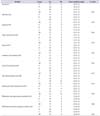1. Joshi HB, Stainthorpe A, Keeley FX Jr, MacDonagh R, Timoney AG. Indwelling ureteral stents: evaluation of quality of life to aid outcome analysis. J Endourol. 2001; 15:151–154.
2. Leibovici D, Cooper A, Lindner A, Ostrowsky R, Kleinmann J, Velikanov S, et al. Ureteral stents: morbidity and impact on quality of life. Isr Med Assoc J. 2005; 7:491–494.
3. Joshi HB, Newns N, Stainthorpe A, MacDonagh RP, Keeley FX Jr, Timoney AG. Ureteral stent symptom questionnaire: development and validation of a multidimensional quality of life measure. J Urol. 2003; 169:1060–1064.
4. Hutchinson A, Bentzen , Konig-Zahn C. Cross-cultural health outcome assessment: A user's guide. Ruinen: European Research Group on Health Outcomes;1996.
5. Puichaud A, Larre S, Bruyere F, Auger J, Bret N, Chevreste A, et al. The French linguistic validation of the Ureteric Stent Symptom Questionnaire (USSQ). Prog Urol. 2010; 20:210–213.
6. Giannarini G, Keeley FX Jr, Valent F, Milesi C, Mogorovich A, Manassero F, et al. The Italian linguistic validation of the ureteral stent symptoms questionnaire. J Urol. 2008; 180:624–628.
7. Park J, Shin DW, You C, Chung KJ, Han DH, Joshi HB, et al. Cross-cultural application of the Korean version of Ureteral Stent Symptoms Questionnaire. J Endourol. 2012; 26:1518–1522.
8. Sanguedolce F, Millan-Rodriguez F, Santillana-Altimira JM, Fantova-Alonso A, Sanchez-Martin FM, Angerri-Feu O, et al. The Spanish linguistic validation of the ureteral stent symptom questionnaire. J Endourol. 2014; 28:237–242.
9. Lamb AD, Vowler SL, Johnston R, Dunn N, Wiseman OJ. Meta-analysis showing the beneficial effect of α-blockers on ureteric stent discomfort. BJU Int. 2011; 108:1894–1902.
10. Park SC, Jung SW, Lee JW, Rim JS. The effects of tolterodine extended release and alfuzosin for the treatment of double-j stent-related symptoms. J Endourol. 2009; 23:1913–1917.
11. Al-Kandari AM, Al-Shaiji TF, Shaaban H, Ibrahim HM, Elshebiny YH, Shokeir AA. Effects of proximal and distal ends of double-J ureteral stent position on postprocedural symptoms and quality of life: a randomized clinical trial. J Endourol. 2007; 21:698–702.
12. Candela JV, Bellman GC. Ureteral stents: impact of diameter and composition on patient symptoms. J Endourol. 1997; 11:45–47.
13. Damiano R, Autorino R, De Sio M, Cantiello F, Quarto G, Perdona S, et al. Does the size of ureteral stent impact urinary symptoms and quality of life? A prospective randomized study. Eur Urol. 2005; 48:673–678.
14. Erturk E, Sessions A, Joseph JV. Impact of ureteral stent diameter on symptoms and tolerability. J Endourol. 2003; 17:59–62.
15. Giannarini G, Keeley FX Jr, Valent F, Manassero F, Mogorovich A, Autorino R, et al. Predictors of morbidity in patients with indwelling ureteric stents: results of a prospective study using the validated Ureteric Stent Symptoms Questionnaire. BJU Int. 2011; 107:648–654.
16. Rane A, Saleemi A, Cahill D, Sriprasad S, Shrotri N, Tiptaft R. Have stent-related symptoms anything to do with placement technique? J Endourol. 2001; 15:741–745.
17. Ho CH, Chen SC, Chung SD, Lee YJ, Chen J, Yu HJ, et al. Determining the appropriate length of a double-pigtail ureteral stent by both stent configurations and related symptoms. J Endourol. 2008; 22:1427–1431.
18. Calvert RC, Wong KY, Chitale SV, Irving SO, Nagarajan M, Biyani CS, et al. Multi-length or 24 cm ureteric stent? A multicentre randomised comparison of stent-related symptoms using a validated questionnaire. BJU Int. 2013; 111:1099–1104.
19. Lingeman JE, Preminger GM, Goldfischer ER, Krambeck AE. Comfort Study Team. Assessing the impact of ureteral stent design on patient comfort. J Urol. 2009; 181:2581–2587.
20. Holm S. A simple sequentially rejective multiple test procedure. Scand J Stat. 1979; 6:65–70.
21. Dellis A, Joshi HB, Timoney AG, Keeley FX Jr. Relief of stent related symptoms: review of engineering and pharmacological solutions. J Urol. 2010; 184:1267–1272.
22. Ritter M, Krombach P, Knoll T, Michel MS, Haecker A. Initial experience with a newly developed antirefluxive ureter stent. Urol Res. 2012; 40:349–353.
23. Joshi HB, Chitale SV, Nagarajan M, Irving SO, Browning AJ, Biyani CS, et al. A prospective randomized single-blind comparison of ureteral stents composed of firm and soft polymer. J Urol. 2005; 174:2303–2306.
24. Krambeck AE, Walsh RS, Denstedt JD, Preminger GM, Li J, Evans JC, et al. A novel drug eluting ureteral stent: a prospective, randomized, multicenter clinical trial to evaluate the safety and effectiveness of a ketorolac loaded ureteral stent. J Urol. 2010; 183:1037–1042.
25. Andersson KE. Bladder activation: afferent mechanisms. Urology. 2002; 59:5 Suppl 1. 43–50.
26. Chew BH, Knudsen BE, Nott L, Pautler SE, Razvi H, Amann J, et al. Pilot study of ureteral movement in stented patients: first step in understanding dynamic ureteral anatomy to improve stent comfort. J Endourol. 2007; 21:1069–1075.




 PDF
PDF ePub
ePub Citation
Citation Print
Print








 XML Download
XML Download